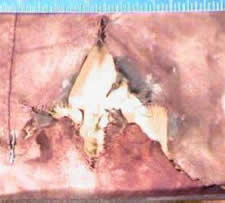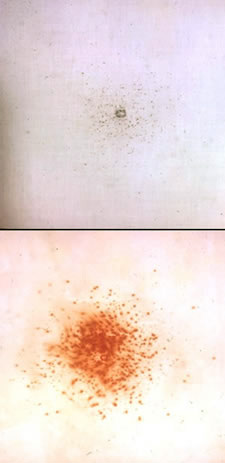Home | Glossary | Resources | Help | Contact Us | Course Map
Archival Notice
This is an archive page that is no longer being updated. It may contain outdated information and links may no longer function as originally intended.
Distance Determination
The next step involves the interpretation of the positive results acquired during the performance of gunshot residue analyses in the previously described sequence of tests. These results are the basis for comparison with known-distance test firings of residue patterns. Positive results are duplicated to create known standards by firing the evidence firearm and ammunition at test targets under controlled conditions. Several types of detectable residues may be deposited and will vary with the distance from the target.
While gunshot residues hold significant potential for determining the facts in a shooting incident, there are also limitations. Some types of residues may be strongly indicative of or consistent with the discharge of a firearm. However, these same residues may have no value in determining the distance involved because the deposits do not constitute reproducible patterns, only random effects of firing the firearm.
The types of positive and negative data that should be noted based on the examinations include
- the Modified Griess Test results for the presence of reproducible patterns of nitrite residues, or simply scattered residues for which a maximum distance for deposition can be determined,
- the Dithiooxamide Test results for the presence of bullet wipe consistent with the passage of a copper-bearing bullet,
- the Sodium Rhodizonate Test results for the presence of particulate lead only, consistent with the discharge of a firearm; bullet wipe consistent with the passage of a lead-bearing bullet; or vaporous lead residue for which a maximum distance for deposition can be determined.
Significance of Results
A prime consideration in the interpretation of any type of gunshot residue is that conclusions must be given as a result of the presence of residue(s). All gunshot residues and physical effects should be mutually corroborative and consistent unless some extraordinary circumstance existed before, during, or after a shooting incident. Thus, the results of the Modified Griess Test, the Dithiooxamide Test, and the Sodium Rhodizonate Test should not be in conflict with each other or with any physical effects present.
The absence of gunshot residue cannot be used as a basis for distance determination. Only residues that are observed as present are a basis for reproduction and comparison.
Residues may be absent for a number of reasons:
- Careless evidence handling
- Life-saving efforts of emergency medical personnel
- An intervening object at the time of discharge
- Masking of gunshot residues by dried blood or other debris
- Shot fired from a distance beyond the maximum distance for the deposit of any residue
Contact Shot
The most basic type of distance determination occurs when the muzzle of the firearm is in contact with the target at the time of discharge. When fired at close range, the bullet, high velocity gases, and residues commonly cause gross physical effects and residue deposits that are easily observed by the unaided eye.
The physical effects that indicate a contact shot may include
- ripping and tearing of cloth,
- burning and/or singeing of cloth,
- melted tips of artificial fibers,
- heavy vaporous lead (smoke) deposits around a suspected bullet hole.
The Modified Griess Test and the Sodium Rhodizonate Test may yield positive results and are confirmatory in nature if the physical effects are sufficient to support the conclusion of a contact shot. Because these effects indicate a contact situation (regardless of caliber or cartridge type), no suspect firearm is required to confirm distance.
Nitrite Residues
As the muzzle-to-target distance increases, the presence of nitrite residues becomes more important in determining distance. Patterns of chemically detectable nitrite residues of varying size and density can be found around a suspected bullet hole. These are extremely useful deposits and are often not visible, even microscopically. Through the application of the Modified Griess Test, these patterns can be detected. The patterns increase in diameter and decrease in density up to a point where no discernable pattern exists, simply scattered positive results. At greater muzzle-to-target distances, no nitrite residues will be deposited.
When a pattern of nitrite deposits is found around a suspected bullet hole, it is possible to reproduce this pattern using the suspect firearm and ammunition. When only scattered nitrite residues (not in a pattern) are found around a suspected bullet hole, it is possible to fire a succession of known distance patterns using the suspect firearm and ammunition to determine the maximum muzzle-to-target distance.
Visible Gunpowder
Prior to the ability to chemically test for nitrites, visible unburned or partially burned powder residues were used as a basis for a pattern or for a maximum distance determination. However, this obsolete approach ignores the frequently invisible nitrite residues and limits the specificity of the conclusion. Visible examination without chemical confirmation does not constitute a complete examination or an appropriate basis for conclusions presented in court.
Additional Online Courses
- What Every First Responding Officer Should Know About DNA Evidence
- Collecting DNA Evidence at Property Crime Scenes
- DNA – A Prosecutor’s Practice Notebook
- Crime Scene and DNA Basics
- Laboratory Safety Programs
- DNA Amplification
- Population Genetics and Statistics
- Non-STR DNA Markers: SNPs, Y-STRs, LCN and mtDNA
- Firearms Examiner Training
- Forensic DNA Education for Law Enforcement Decisionmakers
- What Every Investigator and Evidence Technician Should Know About DNA Evidence
- Principles of Forensic DNA for Officers of the Court
- Law 101: Legal Guide for the Forensic Expert
- Laboratory Orientation and Testing of Body Fluids and Tissues
- DNA Extraction and Quantitation
- STR Data Analysis and Interpretation
- Communication Skills, Report Writing, and Courtroom Testimony
- Español for Law Enforcement
- Amplified DNA Product Separation for Forensic Analysts



